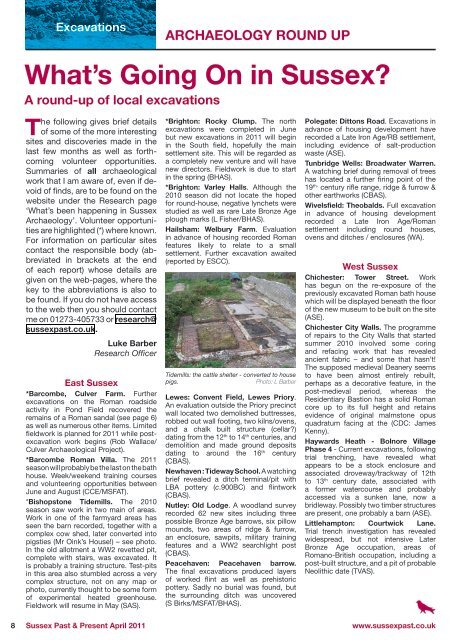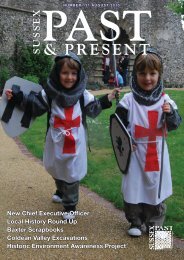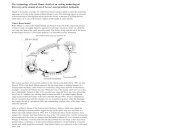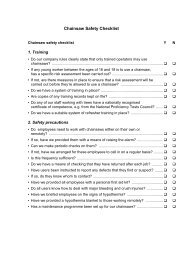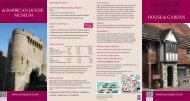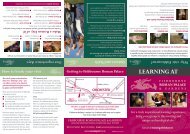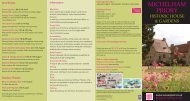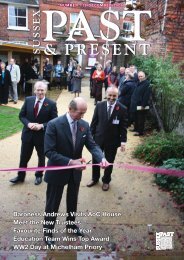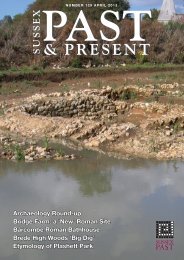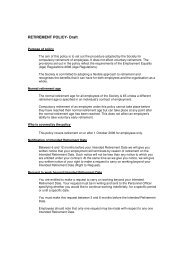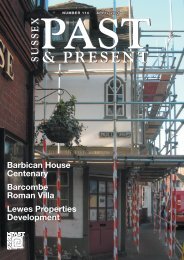April 2011 (issue 123) - The Sussex Archaeological Society
April 2011 (issue 123) - The Sussex Archaeological Society
April 2011 (issue 123) - The Sussex Archaeological Society
Create successful ePaper yourself
Turn your PDF publications into a flip-book with our unique Google optimized e-Paper software.
Excavations<br />
ARCHAEOLOGY ROUND UP<br />
BARCOMBE<br />
Research<br />
Excavations<br />
What’s Going On in <strong>Sussex</strong>?<br />
A round-up of local excavations<br />
<strong>The</strong> following gives brief details<br />
of some of the more interesting<br />
sites and discoveries made in the<br />
last few months as well as forthcoming<br />
volunteer opportunities.<br />
Summaries of all archaeological<br />
work that I am aware of, even if devoid<br />
of finds, are to be found on the<br />
website under the Research page<br />
‘What’s been happening in <strong>Sussex</strong><br />
Archaeology’. Volunteer opportunities<br />
are highlighted (*) where known.<br />
For information on particular sites<br />
contact the responsible body (abbreviated<br />
in brackets at the end<br />
of each report) whose details are<br />
given on the web-pages, where the<br />
key to the abbreviations is also to<br />
be found. If you do not have access<br />
to the web then you should contact<br />
me on 01273-405733 or research@<br />
sussexpast.co.uk.<br />
Luke Barber<br />
Research Officer<br />
East <strong>Sussex</strong><br />
*Barcombe, Culver Farm. Further<br />
excavations on the Roman roadside<br />
activity in Pond Field recovered the<br />
remains of a Roman sandal (see page 6)<br />
as well as numerous other items. Limited<br />
fieldwork is planned for <strong>2011</strong> while postexcavation<br />
work begins (Rob Wallace/<br />
Culver <strong>Archaeological</strong> Project).<br />
*Barcombe Roman Villa. <strong>The</strong> <strong>2011</strong><br />
season will probably be the last on the bath<br />
house. Week/weekend training courses<br />
and volunteering opportunities between<br />
June and August (CCE/MSFAT).<br />
*Bishopstone Tidemills. <strong>The</strong> 2010<br />
season saw work in two main of areas.<br />
Work in one of the farmyard areas has<br />
seen the barn recorded, together with a<br />
complex cow shed, later converted into<br />
pigsties (Mr Oink’s House!) – see photo.<br />
In the old allotment a WW2 revetted pit,<br />
complete with stairs, was excavated. It<br />
is probably a training structure. Test-pits<br />
in this area also stumbled across a very<br />
complex structure, not on any map or<br />
photo, currently thought to be some form<br />
of experimental heated greenhouse.<br />
Fieldwork will resume in May (SAS).<br />
*Brighton: Rocky Clump. <strong>The</strong> north<br />
excavations were completed in June<br />
but new excavations in <strong>2011</strong> will begin<br />
in the South field, hopefully the main<br />
settlement site. This will be regarded as<br />
a completely new venture and will have<br />
new directors. Fieldwork is due to start<br />
in the spring (BHAS).<br />
*Brighton: Varley Halls. Although the<br />
2010 season did not locate the hoped<br />
for round-house, negative lynchets were<br />
studied as well as rare Late Bronze Age<br />
plough marks (L Fisher/BHAS).<br />
Hailsham: Welbury Farm. Evaluation<br />
in advance of housing recorded Roman<br />
features likely to relate to a small<br />
settlement. Further excavation awaited<br />
(reported by ESCC).<br />
Tidemills: the cattle shelter - converted to house<br />
pigs.<br />
Photo: L Barber<br />
Lewes: Convent Field, Lewes Priory.<br />
An evaluation outside the Priory precinct<br />
wall located two demolished buttresses,<br />
robbed out wall footing, two kilns/ovens,<br />
and a chalk built structure (cellar?)<br />
dating from the 12 th to 14 th centuries, and<br />
demolition and made ground deposits<br />
dating to around the 16 th century<br />
(CBAS).<br />
Newhaven : Tideway School. A watching<br />
brief revealed a ditch terminal/pit with<br />
LBA pottery (c.900BC) and flintwork<br />
(CBAS).<br />
Nutley: Old Lodge. A woodland survey<br />
recorded 62 new sites including three<br />
possible Bronze Age barrows, six pillow<br />
mounds, two areas of ridge & furrow,<br />
an enclosure, sawpits, military training<br />
features and a WW2 searchlight post<br />
(CBAS).<br />
Peacehaven: Peacehaven barrow.<br />
<strong>The</strong> final excavations produced layers<br />
of worked flint as well as prehistoric<br />
pottery. Sadly no burial was found, but<br />
the surrounding ditch was uncovered<br />
(S Birks/MSFAT/BHAS).<br />
Polegate: Dittons Road. Excavations in<br />
advance of housing development have<br />
recorded a Late Iron Age/RB settlement,<br />
including evidence of salt-production<br />
waste (ASE).<br />
Tunbridge Wells: Broadwater Warren.<br />
A watching brief during removal of trees<br />
has located a further firing point of the<br />
19 th- century rifle range, ridge & furrow &<br />
other earthworks (CBAS).<br />
Wivelsfield: <strong>The</strong>obalds. Full excavation<br />
in advance of housing development<br />
recorded a Late Iron Age/Roman<br />
settlement including round houses,<br />
ovens and ditches / enclosures (WA).<br />
West <strong>Sussex</strong><br />
Chichester: Tower Street. Work<br />
has begun on the re-exposure of the<br />
previously excavated Roman bath house<br />
which will be displayed beneath the floor<br />
of the new museum to be built on the site<br />
(ASE).<br />
Chichester City Walls. <strong>The</strong> programme<br />
of repairs to the City Walls that started<br />
summer 2010 involved some coring<br />
and refacing work that has revealed<br />
ancient fabric – and some that hasn’t!<br />
<strong>The</strong> supposed medieval Deanery seems<br />
to have been almost entirely rebuilt,<br />
perhaps as a decorative feature, in the<br />
post-medieval period, whereas the<br />
Residentiary Bastion has a solid Roman<br />
core up to its full height and retains<br />
evidence of original malmstone opus<br />
quadratum facing at the (CDC: James<br />
Kenny).<br />
Haywards Heath - Bolnore Village<br />
Phase 4 - Current excavations, following<br />
trial trenching, have revealed what<br />
appears to be a stock enclosure and<br />
associated droveway/trackway of 12th<br />
to 13 th century date, associated with<br />
a former watercourse and probably<br />
accessed via a sunken lane, now a<br />
bridleway. Possibly two timber structures<br />
are present, one probably a barn (ASE).<br />
Littlehampton: Courtwick Lane.<br />
Trial trench investigation has revealed<br />
widespread, but not intensive Later<br />
Bronze Age occupation, areas of<br />
Romano-British occupation, including a<br />
post-built structure, and a pit of probable<br />
Neolithic date (TVAS).<br />
Roman Baths at Barcombe<br />
Complex Roman bathing arrangements revealed<br />
Since 2008 we have been<br />
investigating a large Roman<br />
bath house located in Church Field,<br />
which lies between the villa site and<br />
St Mary’s Church, Barcombe. <strong>The</strong><br />
excavations in 2008, 2009 and 2010<br />
revealed a structure in excess of 20<br />
m long and 6 m wide and orientated<br />
north-east to south-west.<br />
At the northern end of the<br />
complex is a rectangular furnace<br />
room (praefurnium) with walls<br />
made of mortared flints. This<br />
room had a Y-shaped linear cut<br />
at floor level, which ran from the<br />
furnace through its south wall, and<br />
continued outside the building as<br />
a ‘ditch’ to the main drain running<br />
along the south side of the baths.<br />
This cut had been blocked at the<br />
furnace end and could be either<br />
an air vent or more likely a drain,<br />
perhaps indicating that this room<br />
was not fully roofed.<br />
Work in 2010 on the apsidal hot<br />
room (caldarium) concentrated<br />
on final recording before this<br />
room and its hypocaust pilae tile<br />
stacks and the furnace room were<br />
backfilled. Beyond, the warm<br />
room (tepidarium), which contains<br />
some pilae columns and traces of<br />
another pair of facing and outward<br />
projecting apses, are two more<br />
stoke holes on the north side of<br />
the building. <strong>The</strong>se appear to<br />
represent two consecutive phases<br />
of the bath house. One of the stoke<br />
holes vents under the floor of the<br />
immediately adjacent (?apsidal)<br />
room, and then through an arch<br />
into a second room. This stoke<br />
hole then appears to have been<br />
replaced by an adjacent larger one<br />
which heated the adjoining room. It<br />
is possible that this room and that<br />
directly to the south-east were a hot<br />
dry room (laconicum) and changing<br />
room (apodyterium) respectively, or<br />
alternatively they may relate to a<br />
different phase of the baths.<br />
To the south-west of these rooms<br />
is a possible cold room (frigidarium)<br />
with chalk wall foundations, and to<br />
the south of this was, we think, a<br />
corridor and the main entrance. It<br />
is uncertain however how the open<br />
drain that runs along the side of<br />
the building was crossed to access<br />
the entrance. At the west end of<br />
the complex there is another room<br />
with chalk foundations which again<br />
seems to be an addition to the baths<br />
complex. Neither of these western<br />
rooms appears to have been heated<br />
and they are separated by a small<br />
corridor. <strong>The</strong> room at the west<br />
end has substantial foundations,<br />
probably constructed to deal with<br />
the challenge of the wet ground<br />
here adjacent to a possibly tidal<br />
creek from the river Ouse (see<br />
Allen in SP&P 120, 7). This large<br />
room, which is currently only partly<br />
excavated, may be a cold plunge<br />
with a chalk foundation base for a<br />
shelf or walkway around the edge<br />
of the bath.<br />
<strong>The</strong> drainage ditch along the<br />
south side of the bath house has<br />
now been traced around the eastern<br />
end and along the north side of the<br />
building where its relationship to<br />
the two stoke holes is still being<br />
investigated. Large quantities of<br />
artefacts have now been recovered<br />
from this ditch, including pottery,<br />
animal bone and a few coins. A dog<br />
burial at the junction of the drain<br />
from the furnace room and the<br />
drain on the south side of the baths<br />
is possibly a termination deposit.<br />
Further west, at the junction of a<br />
drain from the bath house into the<br />
main drain, was perhaps another<br />
such deposit, this time a crushed<br />
pot that appeared to have been<br />
deliberately placed on the bottom<br />
of the ditch.<br />
Although we have now excavated<br />
most of the baths, it is still not<br />
possible to be certain whether we<br />
are dealing with a single building,<br />
albeit much altered over time, or<br />
a later bath house replacing an<br />
earlier one that had gone out of<br />
use. <strong>The</strong> robbing out of the stone<br />
walls, probably in Roman times,<br />
has removed much of the evidence<br />
for the sequence of construction.<br />
If it is a single building, then the<br />
finished structure represents one of<br />
the largest bath houses in southern<br />
Britain, with a capacity way beyond<br />
the needs of the adjacent villa and<br />
its workforce. Similar sized bath<br />
houses on Hadrian’s Wall served<br />
garrisons of 500 men or more.<br />
With the emerging evidence for an<br />
adjacent tidal creek are we now<br />
looking at a facility which served<br />
travellers and traders, perhaps<br />
functioning as part of a mansio<br />
complex? <strong>The</strong> <strong>2011</strong> excavations<br />
may well be our last at the site, but<br />
we hope to answer the remaining<br />
questions about this enigmatic<br />
bath house.<br />
<strong>2011</strong> and Getting Involved<br />
<strong>The</strong> excavations this year will<br />
start on Saturdays in late May<br />
and continue until late August.<br />
During July and August there will<br />
be a range of 1-, 2- and 5-day<br />
training courses which are ideal<br />
for beginners or those with some<br />
experience (see Noticeboard,<br />
page 4 and www.sussex.ac.uk/<br />
cce/barcombe). For details about<br />
volunteer work contact Chris Butler<br />
(01323 871021 or www.cbasltd.<br />
co.uk). <strong>The</strong>re will be a general<br />
public ‘Open Afternoon’ on Sunday<br />
31 July, 1-5pm (parking available in<br />
Church Field) and a <strong>Society</strong> visit on<br />
23 June (see Noticeboard).<br />
Chris Butler & David Rudling<br />
<strong>Sussex</strong> Past & Present <strong>April</strong> <strong>2011</strong><br />
www.sussexpast.co.uk www.romansinsussex.co.uk <strong>Sussex</strong> Past & Present <strong>April</strong> <strong>2011</strong>


